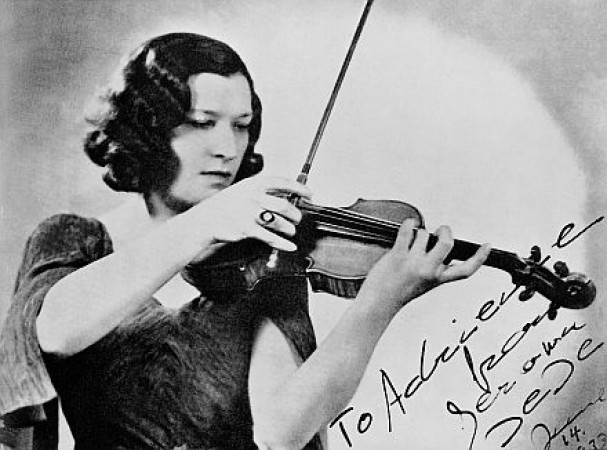
30 May 1895, Budapest – 30 March 1966, Florence
'A talent like her is born once in a century.' This statement comes from the great Hungarian violinist of the nineteenth century, Josef Joachim, who made the honorable assertion listening to one of his young relatives' playing. The little relative was the grand-daughter of Joachim's sister, Jelly Arányi, being only ten years old at that time. At the beginning she played the piano but became interested soon in the violin as an effect of her sister, Adila, who also had a serious artistic career later. She was admitted to the Academy of Music at the age of six already, due to her exceptional skills. She studied with Wilmos Grünfeld between 1901 and 1904 and then she became a student of Jenő Hubay - who educated several talents - between 1904 and 1908.
She gave recitals throughout Europe between 1908 and 1914 with her sisters, Adila and the pianist Hortense. It was the first time that she played in Vienna, Paris and more Italian towns. Though most often she visited England where she became soon a favorite of the aristocracy and musical life with her sisters as a result of the relationships of the recently died Joachim in the country. She chose England as her second homeland with her family in 1914, where she spent most of her life, except her travels abroad and her last years in Italy.
The year 1914 started promisingly: it was the first time in Jelly's life to perform with Pablo Casals. Though the beginning of World War I decelerated the unfolding of the careers of the Arányi-sisters, and therefore Jelly's, too. But life did not stop. Jelly organized occasional string- and piano quartets for private performances with Adila, and gave public recitals in countryside schools. Her first London recital could come true only after the war on February 10, 1919. That was followed by two highly successful concerts six and nine months later. The artist, who fascinated the audience with the vitality of her performance and richness of her expression, was lauded with the highest praises by the critics. One of her admirers wrote the following on her: ‘Miss Jelly Arányi is one of the greatest female violinists of our time, if not the greatest. […] She stands out a head above her contemporaries.'
Her triumph continued in the twenties of the century. Her gorgeous performance captivated not only the audience, but inspired the contemporary composers, as well. Béla Bartók, after hearing Jelly's playing at some informal performances in Budapest in 1921, composed two sonatas for violin and piano; the first in 1921, the second a year later. Both works were premiered by the artist and the composer in England.
The concert of Jelly Arányi and Bartók in Paris must have been an extraordinary musical event; a number of contemporary composers like Igor Stravinsky, the Polish Karol Szymanowsky and Maurice Ravel heard their performance. The young artist made such a deep impression on Ravel that he decided to compose a virtuosic concert piece for her. The work titled Tzigane was finished in 1924, and premiered by Jelly Aranyi. She was eager to include the piece in her concert programs later, as well. Her English admirer and composer friend, Vaughan Williams surprised Jelly with the dedication of his work, Concerto Accademico in 1925. The piece was premiered by the artist in the same year, already.
She toured several times in America, in the Netherlands, Belgium, and Ireland in the second half of the twenties, touring in Spain in 1928 where she could play again with Casals whose artistry she admired in her entire life. She reached the top of her career in the decade preceding World War II. She fulfilled several invitations, and additionally joined a charity concert series –with extraordinary devotion and desire to help- that was attended by thousands of people in churches of London and the countryside in 1933, and the income of which was spent on the aiding of people became impoverished due to the economic crisis. She performed with Myra Hess regularly, whose pianistic personality perfectly complemented her own style of playing and with whom she played together for some twenty years. She also started to search for the forgotten Violin Concerto of Schumann in these years - that was premiered by her in 1938 in England.
After World War II the aging and ailing artist played far fewer and performed even less in public. In the last two decades of her life she performed in solo or with her sister, Adila rather in private houses or at gatherings of friends. At some occasions she appeared before greater audiences with her niece Adrienne, herself being an outstanding violinist, too. She moved to Florence with Adila in 1957. She gave her last recital on October 5, 1965 there, as well.
P. Cs.


